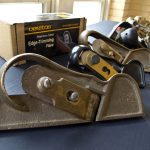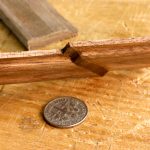We may receive a commission when you use our affiliate links. However, this does not impact our recommendations.
I’ve been turning for about seven years now and have completed hundreds of objects ranging from table legs to large bowls to tiny bottle stoppers. Yet I’d never undertaken a large-diameter (in this case 24″) turning, and frankly, I was a bit anxious about it. Turns out it wasn’t nearly as tough as turning a 12″-diameter bowl blank, especially when you start it and the 20-pound chunk of wood is totally out of balance.
My walnut tabletop blank is from a recycled 32″ square coffee table that I made nearly 30 years ago. Over the years, it got rather beat up so I decided to transform it into something entirely different – a 24″ diameter end table – and it gave me a chance to try turning a relatively big top.
My Powermatic 3520B lathe can be set up to turn outboard. The headstock can travel up and down the length of the lathe bed. When moved to the end, the swing over the bed extension mounted below the normal bed is 30+ inches. My 18″-long bed extension came with a tool post accessory that raises the height of the tool rest to where it needs to be.
With regard to safety, the most important consideration when turning a large blank like this is securing it to the spindle. I used a beefy faceplate and six #12 screws that were 1-1/4″ long (the blank is a tad over 1-3/4″ thick). That was about the maximum length I could use given that my goal is to dish out the top to a depth of about 5/8″. Once the blank was mounted on the spindle, I was surprised by how rigid it was, especially when applying pressure near the outside edge.
While I’ve only had time so far to turn the outside diameter to a true circle and flatten the face (there was a bit of run out at the perimeter) I’d say the most surprising part of turning this big disc is how much actual material there is to remove, even when the cut is shallow. There’s just a lot of circumference to deal with.
This weekend I hope to get enough shop time to complete the turning. Oh, yeah: If you wonder about the series of holes drilled in the top, they are all done to the same depth so I can gauge the the depth of my cut across the face of the blank. It’s not easy to achieve a flat surface on wide turnings.
Here are some supplies and tools we find essential in our everyday work around the shop. We may receive a commission from sales referred by our links; however, we have carefully selected these products for their usefulness and quality.










Hey Steve,
Why on earth would you want to turn such a thing, when you could easily and safely make it round with a router and trammel?
Tom
Roger,
Surely you have better things to do! 🙂
Just because the ‘s’ is at the end doesn’t mean we are implying what you said… we know it isn’t Revs per Minutes. It doesn’t sound right to say to ‘increase the RPM’… and there is no other way to express it. The added ‘s’ goes wherever it is appropriate, and you’re right, it is appropriate to mentally insert it to indicate an increase Revolutions per Minute, even if though it is already “revolutions per minute”. “RPM” is a number and the intention is to increase the number. The rpm abbreviation appears as if it were singular and the sentence says we want more of them and that implies we want to pluralize it.
The most important thing is that everyone understands the intention without causing confusion. We hope you weren’t badly confused!! 🙂
BTW, I notice you didn’t use the abbreviation in your explanation… so how would YOU write it using the RPM abbreviation?
Can someone explain to me why Americans talk about RPMs, you did Steve & Craig Jackson at Easy Wood Tools does it? You simply increase or decrease the Revs Per Minute NOT Revs Per Minutes as both of you imply!
I found when turning large table tops(36″ dia) there were other considerations to take into consideration. My table tops were usually made from jointed pieces of wood, In Australia very wide boards are now unavailable, I found that I had to check the weight of each piece before I glued up the boards to make top. The reason i found that the timber density changed from board to board even the same species the only reason I could fathom was if the board came from the center or outside of the trunk. I found that if I did not do this and try and get some even weight distribution across the table top I could not stop the top from vibrating when I weighed the timber and achieved a balance across the table top I had virtually no vibration. Just a thought!